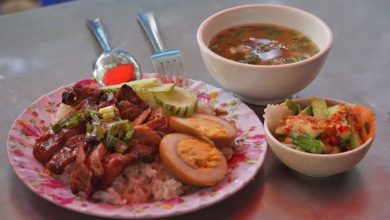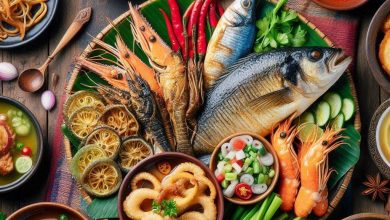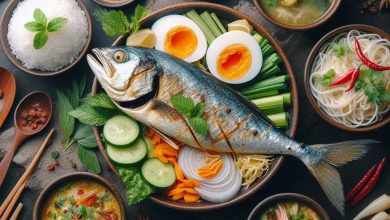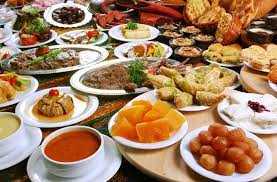“Khmer Culinary Symphony: Unveiling the Rich Tapestry of Cambodian Cuisine”
Khmer Culinary Symphony

Introduction:
Cambodia, a nation tucked away in the center of Southeast Asia, has a rich history, a lively culture, and a bounty of tastes from its verdant surroundings that are reflected in its cuisine. The food of Cambodia, often known as Khmer cuisine, is a tasteful symphony of fresh ingredients, flavorful spices, and unique cooking methods. We will investigate the distinctive tastes, customs, and influences that make Cambodian food a fascinating and unusual culinary experience on this gourmet voyage.
The Spice Palette: A Dance of Aromas and Flavors:
A fascinating variety of spices that blend together to produce a sensory feast are the foundation of Cambodian cuisine. A few of the spices that give Cambodian food its unique flavors and scents are star anise, galangal, turmeric, kaffir lime leaves, and lemongrass. In Khmer cookery, striking the right balance of sweet, sour, salty, and bitter results in a complex and satisfying dish.
Signature Dishes: From Fish Amok to Nom Banh Chok:
The cuisine of Cambodia consists of a number of specialties that encapsulate the essence of the nation’s culinary history. A delicious fish curry cooked in banana leaves, known as fish amok, is a culinary masterwork that demonstrates the deft use of spice. The typical noodle meal of Cambodia, Nom Banh Chok, is made with rice noodles dipped in a tasty green curry sauce made with fish and garnished with a variety of fresh herbs and vegetables.
Street Food Extravaganza: Exploring the Markets:
You can’t have a true taste of Cambodian food without exploring the colorful world of street food. A culinary adventure awaits you in markets like Phsar Thmei in Phnom Penh and Angkor Night Market in Siem Reap, where street sellers expertly prepare dishes like Khmer noodles, Banh Mi sandwiches, and grilled skewers. In addition to tantalizing the taste senses, Cambodia’s street food culture offers an insight into the everyday lives of the people who live there.


Rice, the Heart of Cambodian Meals:
In Cambodian cooking, rice is the main ingredient and the foundation of every meal. The cultivation and preparation of this indispensable grain is a skill that Cambodians have perfected, from the fragrant jasmine rice to the adaptable sticky rice. In a variety of dishes, rice takes center stage. It can be the foundation of curries and stir-fries or the main ingredient in sweet desserts like rice puddings and cakes.
The Delightful Influence of Fresh Produce:
Fresh, regional product is celebrated in Cambodian cuisine. Mangos, bananas, and pineapples are examples of tropical fruits that naturally sweeten a variety of cuisines. Fresh herbs like basil, mint, and cilantro add to the flavorful and fragrant character of Khmer food. The profusion of veggies, which are frequently added to salads and stir-fries, highlights Cambodia’s dedication to healthful and delectable cuisine.
Fish and the Mekong River: A Culinary Connection:
Because of the powerful Mekong River that runs through the country, freshwater fish and Cambodia have a deep bond. Fish is a staple of Khmer cuisine, found in both rivers and the Tonle Sap Lake. Fish curries, grilled fish, and prahok—a traditional fermented fish paste—are all staples of Cambodian cuisine, demonstrating the significance of water resources to the nation’s culinary culture.
Influence of Khmer Rouge: Resilience in Culinary Heritage:
Cambodia was forever changed by the dark years of the Khmer Rouge dictatorship in the 1970s, which had an effect on many facets of society, including cuisine. In spite of all the difficulties and tragedies over this period, Cambodian food has proven remarkably resilient. The culinary legacy endured and traditional recipes were maintained, which is evidence of the resilient nature of the Khmer people.
Ceremonial Feasts: A Tapestry of Tradition and Ritual:
In Cambodian culture, gatherings for ceremonial feasts and meals are highly valued. Traditionally, lavish spreads of Khmer cuisine are served during rituals like weddings and New Year’s festivities. These feasts represent the rich customs and traditions that surround important life milestones in addition to showcasing the variety of Cambodian food.
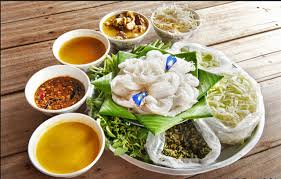
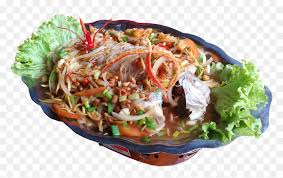
Conclusion:
Explore the gastronomic adventure of Cambodian cuisine, characterized by its deep-rooted customs fresh ingredients, and fragrant spices. Every meal speaks to the history, culture, and resiliency of Cambodia, from the busy marketplaces to the peaceful farmland. Savoring the harmonious blend of tastes found in Khmer cuisine is like taking a culinary trip through a country’s heart and soul as we learn about its culture while simultaneously treating our taste buds to a culinary treat.

